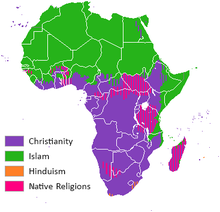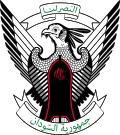Islamization of the Sudan region
| Part of a series on |
Islamization |
|---|
 |

The
Following the 7th century
The proliferation of Islamic influence was largely a gradual process. The Christian kingdoms of
The
Consequently, much of the contemporary Sudan region is
The Arabs
Contacts between Nubians and Arabs long predated the coming of Islam,
The Arabs realized the commercial advantages of peaceful relations with Nubia and used the Baqt to ensure that travel and trade proceeded unhindered across the frontier. The Baqt also contained security arrangements whereby both parties agreed that neither would come to the defense of the other in the event of an attack by a third party. The Baqt obliged both to exchange annual tribute as a goodwill symbol: the Nubians sent slaves and the Arabs sent grain. This formality was only a token of the trade that developed between the two. It was not only a trade in slaves and grain but also in horses and manufactured goods brought to Nubia by the Arabs, and in ivory, gold, gems, gum arabic, and cattle carried back by them to Egypt, or shipped to Arabia.
Acceptance of the Baqt did not indicate Nubian submission to the Arabs; however, the treaty did impose conditions for Arab friendship that eventually permitted Arabs to achieve a privileged position in Nubia. Arab merchants established markets in Nubian towns to facilitate the exchange of grain and slaves. Arab engineers supervised the operation of mines east of the Nile in which they used
to Egypt.Traditional genealogies trace the ancestry of the Nile Valley's mixed population to Arab tribes that migrated into the region during this period. Even many non-Arabic-speaking groups claim descent from Arab forebears. The two most important Arabic-speaking groups to emerge in Nubia were the
Although not all Muslims in the region were Arabic-speaking, acceptance of Islam facilitated the Arabization process. There was no policy of proselytism, however. Islam penetrated the area over a long period of time through intermarriage and contacts with Arab merchants and settlers.[8]
The Funj
| History of Sudan | ||||||||||||||||||
|---|---|---|---|---|---|---|---|---|---|---|---|---|---|---|---|---|---|---|
 | ||||||||||||||||||
| Before 1956 | ||||||||||||||||||
|
||||||||||||||||||
| Since 1955 | ||||||||||||||||||
|
||||||||||||||||||
| By region | ||||||||||||||||||
| By topic | ||||||||||||||||||
|
||||||||||||||||||
| Timeline | ||||||||||||||||||
At the same time that the Ottomans brought northern Nubia into their orbit, a new power, the
The Funj state included a loose confederation of sultanates and dependent tribal chieftains drawn together under the suzerainty of Sennar's mek (sultan). As overlord, the mek received tribute, levied taxes, and called on his vassals to supply troops in times of war. Vassal states in turn relied on the mek to settle local disorders and to resolve internal disputes. The Funj stabilized the region and interposed a military bloc between the Arabs in the north, the Abyssinians in the east, and the non-Muslim blacks in the south.

The sultanate's economy depended on the role played by the Funj in the slave trade. Farming and herding also thrived in Al Jazirah and in the southern rainforests. Sennar apportioned tributary areas into tribal homelands each one termed a dar (pl., dur), where the mek granted the local population the right to use arable land. The diverse groups that inhabited each dar eventually regarded themselves as units of tribes. Movement from one dar to another entailed a change in tribal identification. (Tribal distinctions in these areas in modern Sudan can be traced to this period.) The mek appointed a chieftain (nazir; pl., nawazir) to govern each dar. Nawazir administered dur according to customary law, paid tribute to the mek, and collected taxes. The mek also derived income from crown lands set aside for his use in each dar.
At the peak of its power in the mid-17th century,
Another reason for Sennar's decline may have been the growing influence of its hereditary
The Fur
The sultans operated the slave trade as a monopoly. They levied taxes on traders, and export duties on slaves sent to Egypt, and took a share of the slaves brought into Darfur. Some household slaves advanced to prominent positions in the courts of sultans, and the power exercised by these slaves provoked a violent reaction among the traditional class of Fur officeholders in the late eighteenth century. The rivalry between the slave and traditional elites caused recurrent unrest throughout the next century.
See also
- Muslim conquest of the Maghreb
- Muslim conquest of Egypt
- Sahelian kingdoms
- History of Sudan
- History of Chad
- History of Niger
- History of Mali
- History of Mauritania
- Kingdom of Sennar
- Islam in Ethiopia
- Islam in Somalia
References
- Republic of Sudan (whose borders are those of Anglo-Egyptian Sudan, drawn in 1899) but of the wider Sahel, in Arabic known as bilad as-sudan, "the land of the blacks".
- ISBN 978-1138432192.
- ^ Duta, Paul; Ungureanu, Roxelana (November 2016). "The Sudanese civil war – the effect of arabisation and islamisation". Research and Science Today. 2 (12): 50–59. Retrieved 2020-08-05.
Islam has been introduced in Sudan by several religious orders, each with their own interpretations and dogmas, being able to talk about different sects (tariqa), the Muslim Brotherhood corresponding the schools of Muslim thinking. Each Muslim cult has its own structure, leader, space and after independence from Anglo-Egyptian condominium it has its own political party. The multitude of sects and the differences between them do not permit to speak of a Muslim community; over time, the differences between these sects have generated conflicts, fighting against each other allowing the British and Egyptians to successfully apply the adage 'divide at impera.'
- ^ "The mobilization of local ideas about racial difference has been important in generating, and intensifying, civil wars that have occurred since the end of colonial rule in all of the countries that straddle the southern edge of the Sahara Desert. [...] contemporary conflicts often hearken back to an older history in which blackness could be equated with slavery and non-blackness with predatory and uncivilized banditry." (cover text), Hall, Bruce S., A History of Race in Muslim West Africa, 1600–1960. Cambridge University Press, 2011.
- ISBN 978-0-203-45568-5, retrieved 2023-07-04
- ^ Hoyland, Robert (2015). In God's Path: The Arab Conquest and the Creation of an Islamic Empire. Oxford: Oxford University Press. p. 77.
- ^ Nicoll, Fergus (2004). The Sword of the Prophet. Sutton: Gloucester. p. 55.
- ISBN 978-1-139-03046-5, retrieved 2023-07-04
- ^
Minahan, James B. (30 May 2002). Encyclopedia of the Stateless Nations: Ethnic and National Groups Around the World A-Z. ABC-CLIO. p. 625. ISBN 9780313076961. Retrieved 29 December 2015.
Further reading
 This article incorporates text from this source, which is in the public domain. Country Studies. Federal Research Division. – Sudan
This article incorporates text from this source, which is in the public domain. Country Studies. Federal Research Division. – Sudan- Spencer Trimingham, History of Islam in West Africa. Oxford University Press, 1962.
- Nehemia Levtzion and Randall L. Pouwels (eds). The History of Islam in Africa. Ohio University Press, 2000.
- David Robinson. Muslim Societies in African History. Cambridge University Press, 2004.
- Bruce S. Hall, A History of Race in Muslim West Africa, 1600–1960. Cambridge University Press, 2011, ISBN 9781107002876.
External links
- Trade and the Spread of Islam in Africa, Heilbrunn Timeline of Art History. New York: The Metropolitan Museum of Art (October 2001).
